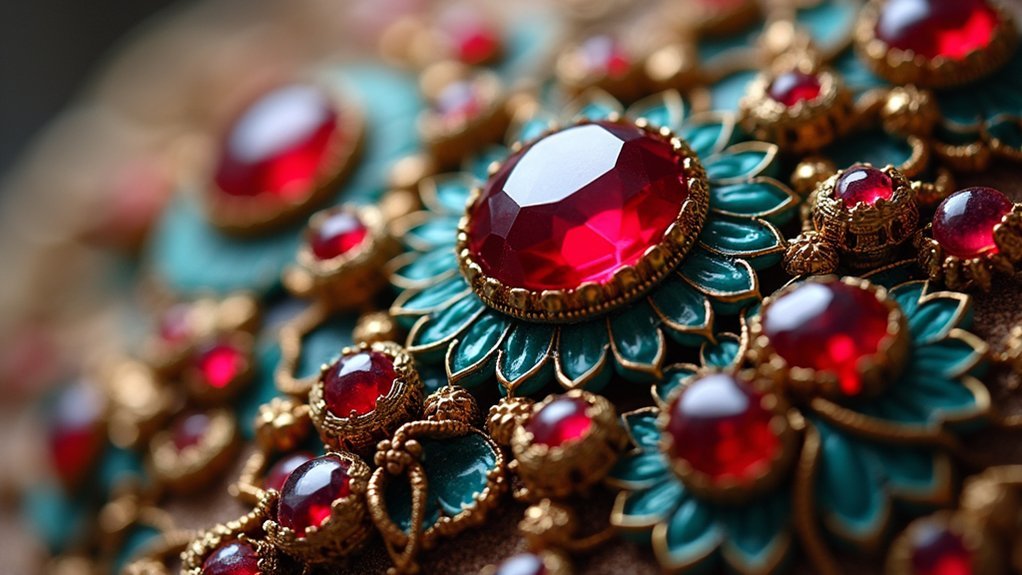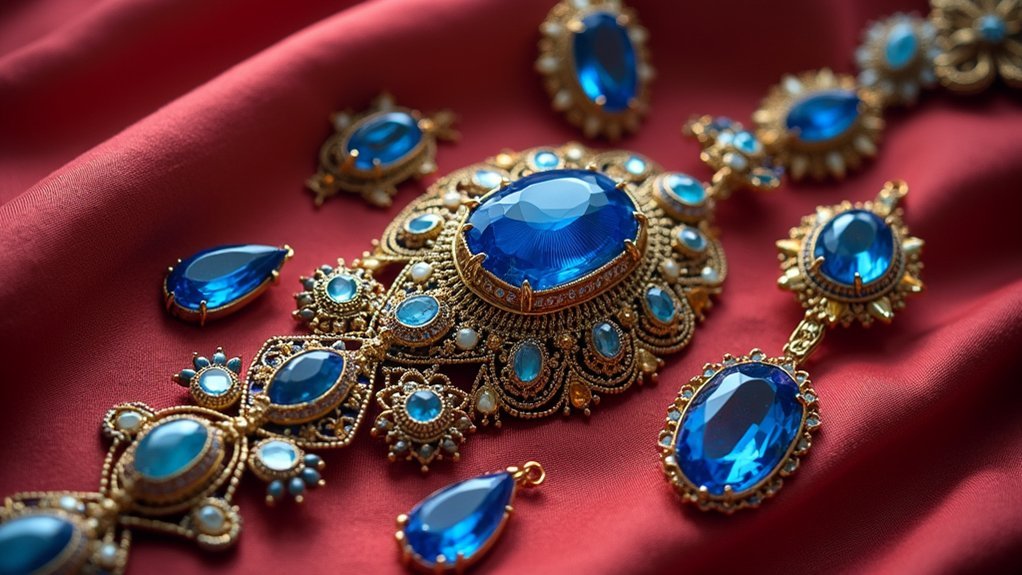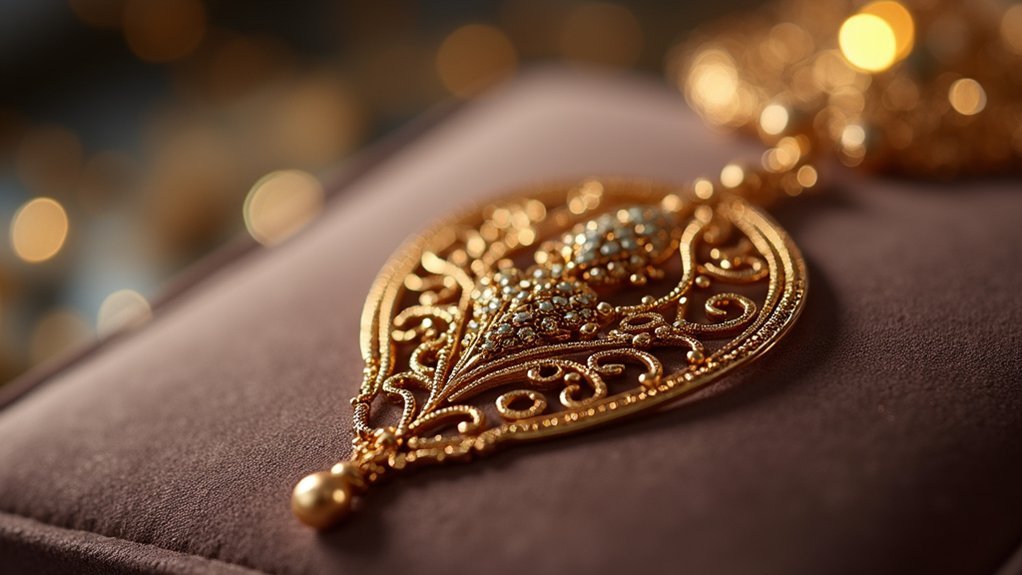The Silk Road transformed global jewelry design by facilitating unprecedented cultural exchange between East and West. You’ll find that artisans shared techniques like lost-wax casting while trading precious materials such as lapis lazuli and turquoise. This cross-pollination created distinctive hybrid styles that blended Persian, Greek, and Indian elements. Symbolic meanings evolved as motifs traveled across continents, establishing a visual language that still influences contemporary designers. Discover how this ancient trade network forever altered the artistic landscape of adornment.
Cultural Fusion: How Eastern and Western Design Elements Merged

While many ancient trade networks facilitated economic exchange, the Silk Road uniquely transformed the world of jewelry design through unprecedented cultural fusion.
You’ll find that as artisans traveled these routes, they exchanged jewelry-making techniques that forever changed their craft. Eastern motifs began appearing in pieces made with Western craftsmanship, creating distinctive hybrid styles that captivated elite consumers across continents.
The flow of trade goods like lapis lazuli and turquoise from Central Asia expanded jewelers’ palettes, enabling more innovative jewelry designs than ever before.
Cultural interactions also transferred the symbolic meanings attached to ornaments—protective amulets from one region found new expression in distant lands.
This dynamic exchange wasn’t merely aesthetic; it reflected evolving tastes and status symbols that crossed borders, proving the Silk Road’s impact extended far beyond simple commerce.
Precious Materials: The Exchange of Gemstones Along Trade Routes
Beyond silks and spices, the Silk Road served as a glittering highway for some of history’s most coveted gemstones.
You’ll find that these precious materials transformed jewelry design across continents as traders carried exotic goods like Afghan lapis lazuli and vibrant turquoise to distant markets.
These gemstones weren’t just decorative—they sparked cultural exchanges that revolutionized artistic traditions worldwide.
- Lapis lazuli traveled from Afghanistan to Egypt and Mesopotamia, becoming integral to royal jewelry
- Turquoise gained prominence in both Persian craftsmanship and Native American designs
- Artisans incorporated foreign techniques with local traditions, creating innovative fusion pieces
- New gemstone combinations emerged as previously isolated cultures shared resources
- Trade routes enabled the democratization of previously regional precious materials, expanding jewelry design possibilities
Evolution of Craftsmanship: Technical Innovations Shared Between Artisans

As traders traversed the ancient Silk Road with their precious cargo, they carried something even more valuable than gemstones—knowledge.
You’ll find that technical innovations spread rapidly among artisans, transforming jewelry design across continents. Craftsmen exchanged sophisticated skills like lost-wax casting, intricate metalworking, and advanced gemstone setting techniques.
These cross-cultural interactions introduced diverse materials—Afghan lapis lazuli and Bamiyan turquoise—that enriched jewelry craftsmanship everywhere. The demand for luxury goods encouraged artisans to experiment, combining Greek, Persian, and Indian elements into hybrid styles.
They didn’t simply adopt foreign aesthetics; they adapted and refined them, creating distinctive decorative techniques that reflected multiple cultural influences. This technical exchange along the Silk Road created a revolutionary evolution in jewelry-making that continues to influence modern designs.
Symbolism and Meaning: The Cross-Pollination of Jewelry Motifs
When travelers exchanged goods along the ancient Silk Road, they simultaneously traded in powerful symbols that would forever alter how jewelry conveyed meaning across cultures.
You’ll find that turquoise and lapis lazuli weren’t merely decorative—they carried status and spiritual significance across diverse civilizations.
- Sogdian artifacts reveal a fascinating blend of Persian and Hellenistic influences
- Greek, Indian, and Middle Eastern motifs merged into Central Asian craftsmanship
- Exotic materials created demand for hybrid styles that reflected multiple cultural values
- Traditional designs transformed as artisans adopted foreign techniques and patterns
- Jewelry became a visual language, communicating cross-cultural symbolism through trade
This exchange went beyond mere aesthetics—the Silk Road facilitated a profound symbolism trade, where each motif carried layers of meaning that transcended borders, creating jewelry that spoke multiple cultural languages simultaneously.
The Legacy of Silk Road Jewelry in Modern Design

The symbolic cross-pollination that flourished on the ancient Silk Road hasn’t disappeared into history—it lives on in the hands of today’s innovative designers.
When you examine contemporary jewelry design, you’ll notice the unmistakable influence of these historic trade routes.
Artisans from Kabul’s Old City create ethical handmade pieces that honor traditional craftsmanship while incorporating modern design elements.
These collections showcase materials like lapis lazuli and turquoise—gems that have traversed the Silk Road for centuries.
You’ll find that today’s designers deliberately draw from the cultural influences and intricate patterns of ancient artifacts, creating a resurgence in cross-cultural jewelry styles.
This modern reinterpretation connects past and present, as the blending of artistic traditions continues to inspire creativity in global jewelry design.
Frequently Asked Questions
Why Were Silk Roads Important to Global Development?
You’ll find that Silk Roads were essential to global development by connecting distant civilizations, facilitating trade of goods and ideas, spreading religions, and enabling cultural exchanges that transformed societies across Eurasia.
How Did Silk Road Contribute to Globalization?
You’ll find that the Silk Road drove globalization by connecting Eastern and Western cultures through trade routes, facilitating exchange of goods, ideas, technologies, and religious beliefs across civilizations for centuries.
How Did the Silk Road Help to Exchange Culture and Ideas?
You’d see merchants exchanging more than goods—they shared stories, religions, and artistic techniques. As you traveled the Silk Road, you’d witness ideas flowing between civilizations, creating cultural fusion that transformed societies worldwide.
Was Jewelry Traded on the Silk Road?
Yes, you’ll find jewelry was a significant trade item on the Silk Road. Merchants exchanged gold, silver, and gemstone pieces, which helped spread diverse artistic styles and techniques between Eastern and Western cultures.
In Summary
You’ve seen how the Silk Road wasn’t just a trade network—it was a jewelry revolution. Through cultural fusion, material exchanges, shared craftsmanship, and symbolic cross-pollination, it forever changed how we design and wear adornments. Today, when you admire contemporary jewelry pieces, you’re witnessing the enduring legacy of this ancient highway that connected East and West through beauty and artistry.





Leave a Reply